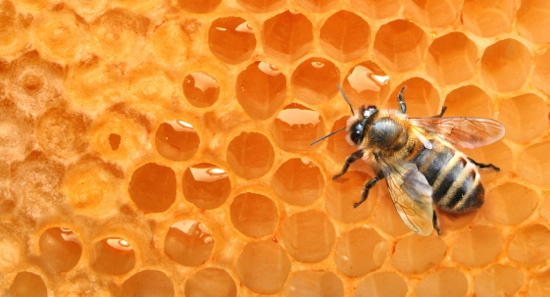Busy, Busy, Busy

Here are a few bee statistics for you. To make one pound of honey bees must fly 55,000 miles and visit some 2 million individual flowers. When you consider that a medium-producing hive will make about 150 pounds of honey a season, that’s a lot of activity. Eight and a quarter million miles flown and 300 million blooms. For one hive.
No wonder worker bees simply wear out after a while. It’s a myth that honey bees are specialized within the hive, that some look after brood, others collect nectar, others pick pollen. Every single worker bee that hatches does every job in the hive over the course of her 40-day life. She starts by taking out the trash, then moves up to become a nursemaid for developing brood, then a hive builder, security guard and finally a forager, the job she’ll do until her wings become so tattered that they can’t lift her anymore. Over the course of her life she’ll make about a tenth of a teaspoon of honey.
The only bees that don’t do anything in the hive — save eat and mate with young queen bees — are the males. These are the drones and there are very few of them in the hive relative to the legions of workers who wait upon them. The gig sounds better than it is. Bees mate in the air and if a drone actually succeeds in finding a virgin queen to copulate with, he literally explodes in act with an audible popping sound. As far as the laying around and eating, that works fairly well until the end of the season when the drones are literally picked up and thrown bodily from the hive to freeze. The reason, because no one needs layabouts hanging around when the hive is scrimping and saving its way through the winter. Life’s tough when you’re a bug.
Oh, and reader Flick — if that IS your real name — wants to know what bees do with pollen. The answer is they eat it (and store it). Bees have a two-pronged diet: honey (carbs) and pollen (protein). Fueled thusly they work, fly and produce wax which they secrete from glands on their abdomen in flakes. It takes about five times as much fuel to make wax as it does to do anything else in the hive, which means it’s very, very precious stuff. Think about that the next time you’re smearing beeswax balm on your lips. Those little critters work mighty hard for us!
That was awesome, Mr Pastry! Thanks for all that great information. 🙂
My pleasure as always, Vanessa!
– Joe
mind. blown.
Pretty cool isn’t it?
Thanks, Katherine!
– Joe
Endlessly fascinating. I recently observed a poor lone bee on my balcony, which for some reason couldn’t seem to take off. Just kept on rolling on the floor. I turned it over on her feet to no avail. Finally a saddened me and a curious bystander cat decided it would be best to “help” it out and then put it to rest in one of the flowerpots. Does death typically find them out in the fields, or do they have an instinct to try and stay close to home towards the end of their life. I’ve also been curious whether each bee deposits it’s own honey in the same cell, or if it does so randomly. I didn’t know it makes only 1/10 of a teaspoon in a lifetime , but seems to me like the capacity of a cell would be about that much?
Hey Dani!
Yes probably a worn-out worker, poor thing! But bees aren’t sentimental as far as I know. Where they drop, they drop. Sometimes that’s in the hive, sometimes its elsewhere. They live a lot longer in the winter as you can probably infer. A bee born before the first frosts will last through to spring and beyond if the hive over-winters successfully. They all huddle up and beat their wings to generate heat, eating honey and pollen to give them the fuel they need.
As far as depositing nectar in cells, they do it wherever there’s a cell that isn’t capped. However usually the ones who bring the nectar in aren’t the ones who spit it into the cells. The foragers off-load their harvest (both nectar and pollen) as soon as they arrive at the hive, then head back out for more. Other bees in the hive pass it between them, evaporating and digesting it, before it goes into a cell for storage. But I’ll bet you’re right that a cell is just about 1/10 a teaspoon. Well observed — and good questions, Dani!
Cheers,
– Joe
Thanks, Joe. I will remember to send some good Alpine honey your way if a trip of mine materializes this summer.
Ooh yeah. Let me know and I’ll end you an address!
Cheers,
– Joe